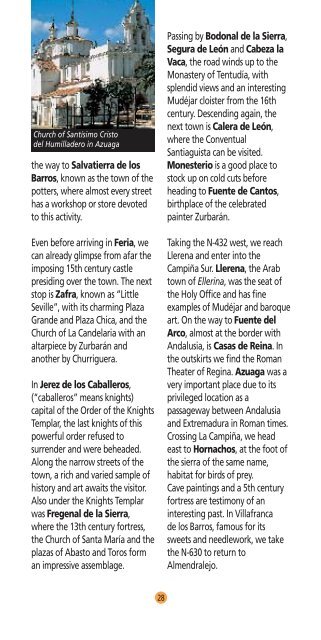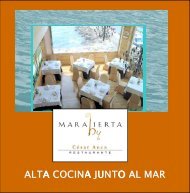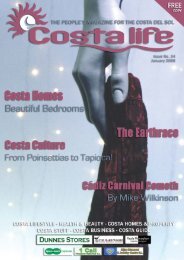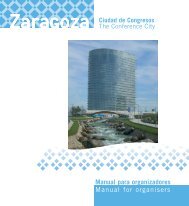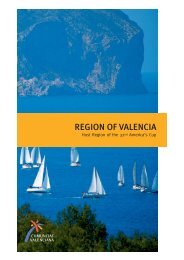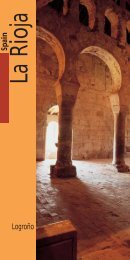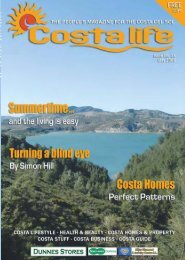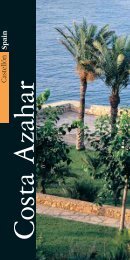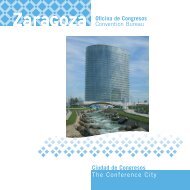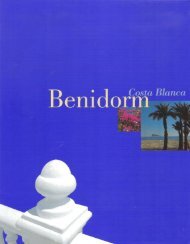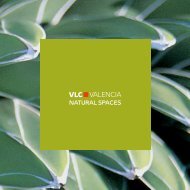Spain Badajoz Cáceres - Tourismbrochures.net
Spain Badajoz Cáceres - Tourismbrochures.net
Spain Badajoz Cáceres - Tourismbrochures.net
You also want an ePaper? Increase the reach of your titles
YUMPU automatically turns print PDFs into web optimized ePapers that Google loves.
Church of Santísimo Cristo<br />
del Humilladero in Azuaga<br />
the way to Salvatierra de los<br />
Barros, known as the town of the<br />
potters, where almost every street<br />
has a workshop or store devoted<br />
to this activity.<br />
Even before arriving in Feria, we<br />
can already glimpse from afar the<br />
imposing 15th century castle<br />
presiding over the town. The next<br />
stop is Zafra, known as “Little<br />
Seville”, with its charming Plaza<br />
Grande and Plaza Chica, and the<br />
Church of La Candelaria with an<br />
altarpiece by Zurbarán and<br />
another by Churriguera.<br />
In Jerez de los Caballeros,<br />
(“caballeros” means knights)<br />
capital of the Order of the Knights<br />
Templar, the last knights of this<br />
powerful order refused to<br />
surrender and were beheaded.<br />
Along the narrow streets of the<br />
town, a rich and varied sample of<br />
history and art awaits the visitor.<br />
Also under the Knights Templar<br />
was Fregenal de la Sierra,<br />
where the 13th century fortress,<br />
the Church of Santa María and the<br />
plazas of Abasto and Toros form<br />
an impressive assemblage.<br />
Passing by Bodonal de la Sierra,<br />
Segura de León and Cabeza la<br />
Vaca, the road winds up to the<br />
Monastery of Tentudía, with<br />
splendid views and an interesting<br />
Mudéjar cloister from the 16th<br />
century. Descending again, the<br />
next town is Calera de León,<br />
where the Conventual<br />
Santiaguista can be visited.<br />
Monesterio is a good place to<br />
stock up on cold cuts before<br />
heading to Fuente de Cantos,<br />
birthplace of the celebrated<br />
painter Zurbarán.<br />
Taking the N-432 west, we reach<br />
Llerena and enter into the<br />
Campiña Sur. Llerena, the Arab<br />
town of Ellerina, was the seat of<br />
the Holy Office and has fine<br />
examples of Mudéjar and baroque<br />
art. On the way to Fuente del<br />
Arco, almost at the border with<br />
Andalusia, is Casas de Reina. In<br />
the outskirts we find the Roman<br />
Theater of Regina. Azuaga was a<br />
very important place due to its<br />
privileged location as a<br />
passageway between Andalusia<br />
and Extremadura in Roman times.<br />
Crossing La Campiña, we head<br />
east to Hornachos, at the foot of<br />
the sierra of the same name,<br />
habitat for birds of prey.<br />
Cave paintings and a 5th century<br />
fortress are testimony of an<br />
interesting past. In Villafranca<br />
de los Barros, famous for its<br />
sweets and needlework, we take<br />
the N-630 to return to<br />
Almendralejo.<br />
28


